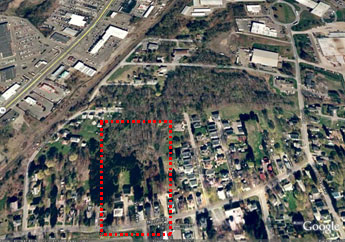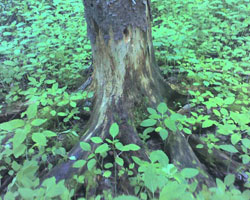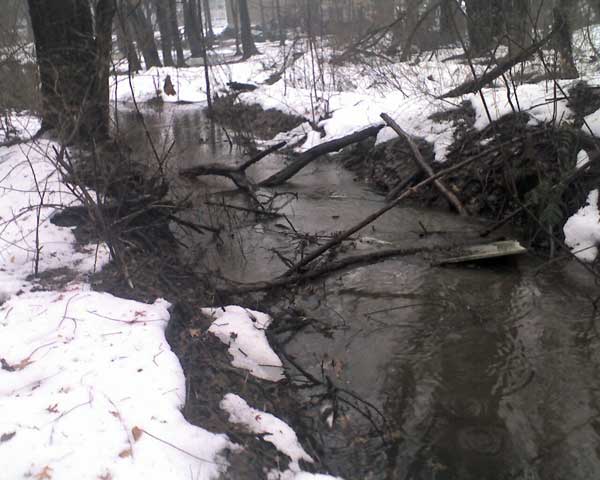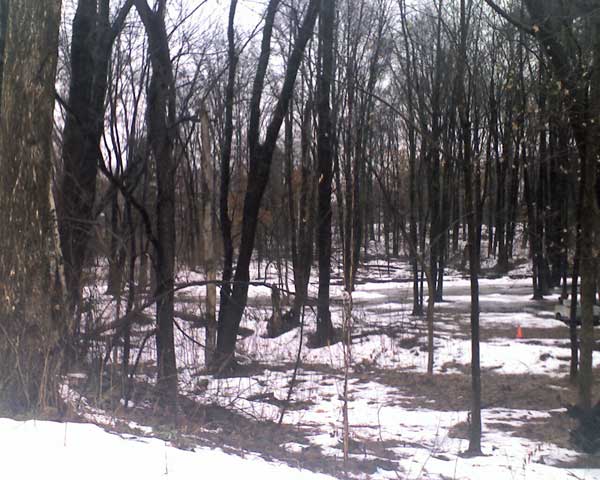“Floodplain forest—a woodland that is regularly inundated with water that moves into the lowlands bordering a river—is a disappearing ecological treasure,” writes Gayle Goddard-Taylor for Mass Audubon’s Sanctuary magazine (March 2006). While some may quibble that the North Street woods are not a forest and Millyard Brook is not a river but an intermittent stream, this article nonetheless suggests reasons why the North Street woods are worth conserving:
“The River is a Restless Spirit – Life in the floodplain forest”
In the northeastern corner of Belmont in the floodplain of the Little River sits a pocket-sized forest…
That this northern floodplain forest is unique in an urban setting is only one of the reasons FAR wants to keep the Belmont Uplands from disappearing beneath a proposed condominium complex. Another is flooding, always a concern in the Alewife watershed of Belmont, Arlington, and Cambridge, which has become more severe in recent years, due in part to the loss of naturally pervious surface to pavement and drainage construction. As small as it is, the Belmont Uplands still provides valuable floodwater storage, according to preservation advocates.
Additionally, the woods and marshes there serve as an important stopover for migrating birds, as well as habitat for a wildlife population that ranges from muskrats and minks to foxes and coyotes. Also, the site’s merit as an urban outdoor classroom has prompted area educators to bring students there for hands-on learning.
Floodplain forest…is a disappearing ecological treasure… [Their] cyclical flooding regime continually refertilizes the floodplain and nourishes the well-adapted trees and understory…
“Apart from preserving ecological habitat, a wildlife corridor, and a greenway,” says Blunt, “the DCR has some very practical reasons for restoring these [floodplain forests along the Connecticut River].” The broad areas of the floodplain forest are natural water-storage areas. During significant floods—and such events can occur any time of the year—water overspreads the flat wetlands and loses velocity. The trees act as filter strips, holding back sediments and reducing the extent of downstream damage…
“Putting housing [in the Belmont Uplands] would be totally un-smart growth,” says FAR’s Ellen Mass. “Basically, the people living here would be surrounded by a mosquito marsh.”
See also:
Kohl’s Condo Proposal: Where Things Stand, and What You Can Do

The urban forest behind North Street is already surrounded by development…

Exposed roots suggest that substantial volumes of water flow over this ground…
Northampton Redoubt: Urban Planning, Public Policies, and Urban Ecology
[Schematic of Kohl Construction’s proposed condo development:]

Above-Douglas Kohl has proposed eliminating units 27-23 and one of the three units shown in the upper left hand corner of the above schematic. Units 28-31 will be shifted further to the east reducing the size of the parking lot, and one unit will likely be added to the south end of the 18-22 bank of units. The total number likely to be proposed is now 26 units. The detention ponds as shown will also be altered, with the elimination of the rectangular pond show about center in the graphic, and the alteration of the three lower ponds as well, due to the relocation of the units…
Photo Essay: Millyard Brook Swells with Water in Winter
…On January 11, a mild and rainy day, Millyard Brook is…helping a large volume of water flow safely through the neighborhood. Adding impervious surface near streams like these can increase the speed and volume of runoff that flows into them and make them more flood-prone. In addition, the pollution from developed areas (e.g. salts, oils, herbicides) can harm the vegetation. As the City of Northampton acknowledges, “Problems with nutrient runoff, erosion, siltation, loss of groundwater recharge, poor water quality, vegetation change and harm to wildlife habitat are greatly exacerbated by activities within 100 feet of wetlands.”
…Kohl Construction’s proposed condos aim to come within 35 feet of the wetlands around Millyard Brook, and presumably it will be necessary to disturb areas that are even closer. As written in the November report of The Sustainable Sites Initiative, “Even lawns and landscape beds, which are generally viewed as more permeable than pavements and roofs, are commonly compacted during construction and installation, resulting in reduced infiltration.[14,27] A residential lawn can be up to 40 percent impervious.[24] Disturbing soils and vegetation can increase dramatically the rate, volume, duration, and frequency of runoff as well as pollutant loadings of stormwater, which can affect water quantity and quality…”
We further recall that a property at the end of View Avenue–over 100 feet from the wetland boundary–reported flood damage from Tropical Storm Floyd in 1999, possibly a sign that the drainage in the area is stretched as it is.


Northampton’s Flood and Natural Hazard Mitigation Plan: Wetlands Buffers of 100 Feet Are an Effective Flood Mitigation Strategy and Should Be Consistently Enforced
Northampton Open Space Plan: “This loss of habitat and natural flood buffering areas is Northampton’s most serious environmental problem”
More Reasons Why Smart People Don’t Build Near Wetlands: Mosquitoes and Disease